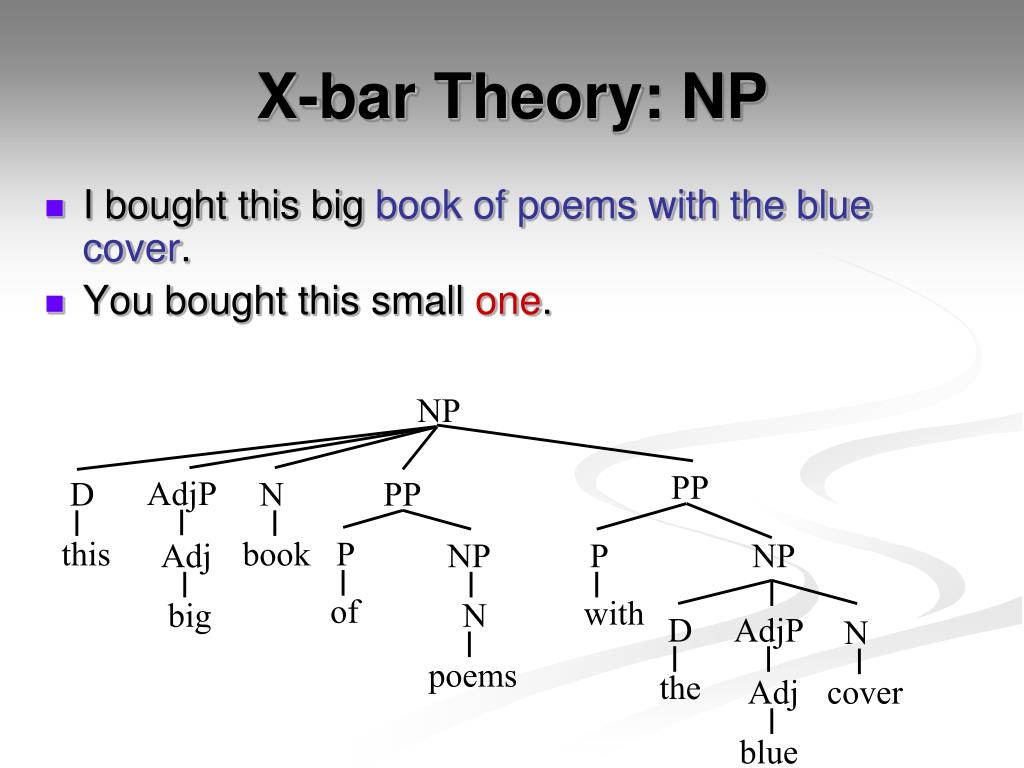

The theory of syntax that we’re working within this class is called X-bar theory. We saw in the last unit how we can use tree diagrams to show these relationships between words, phrases and sentences.

We’ll see that within each sentence, our mental grammar groups words together into phrases and phrases into sentences. Note that SKS don't use brackets at all when they specify the argument structure of a lexical item.We’re starting to look at how our minds organize sentences. PUT IN BOX Notation: The argument structure is given in angle brackets "" sometimes it's given in square brackets "" or parentheses "(…)".PUT IN BOX Notation: In the lexical entry, optionality is indicated by putting parentheses "(…)" around the argument that is optional.Comparison of (1a) and (1d) establishes that the PP argument is optional: it can be there, but it need not be there. Finally, (1d) shows that laugh can introduce a PP Goal as its second argument. (In traditional English grammar, such verbs are called bare infinitives.) And (1c) shows that laugh can't introduce a second DP argument. This is further confirmed by (1b), which is a small clause environment where laugh appears without inflection. Put more succinctly: laugh selects for a DP Agent. Argumentation: Example (1a) establishes that laugh can introduce a single DP argument with the semantic role Agent.This is indicated in the lexical entry by listing the category of laugh ( V) and its argument structure. Sample answer for (1) Laugh is an optionally transitive verb and that introduces an obligatory DP Agent, and an optional PP Goal. The first one is done for you by way of example. (15) Lucy will read the contract very carefully.īefore completing these practice exercises, review §6.8.2 of Sportiche, Koopman and Stabler.įor each of the following words, specify their lexical entry by indicating their category and their selectional properties. (14) Lucy will live in New York with a friend. (13) Lucy can see the incredibly tall woman. (12) Maya must think that Lucy will leave. (11) Lucy might read these books during the holidays. (9) Lucy could buy a used sportscar from Italy from a dealership in Vancouver. (8) Lucy will say that Maya will visit tomorrow. (7) Lucy will visit her cousins in Italy. (6) Lucy will write to her cousins in Italy.

(4) The girl with the red hair should put the heavy book on the table in the corner. (3) Lucy’s older brother will raise cattle. (2) This client might buy that red sportscar. Using X-bar Theory, draw the trees for the following sentences: C, T, D, Num), they select for a unique complement: C selects for a TP complement, T selects for a VP complement, D selects for a NumP complement, Num selects for an NP complement. Complements to V and P are DP or CP complements to N and A are PPs. Once the central role of the "head of a phrase" is recognized, the next step is to recognize that all head can introduce a complement. X' → X YP COMPLEMENT where YP is DP, PP, or CP This property of phrase structure - that all heads (X) have a complement (YP) can also be collapsed into a single general rule: Recognizing that headedness (also called "endocentricity") is a property of all phrase structure rules was the first step to developing what is now known as X-bar Theory. VP → … V … NP → … N … PP → … P … AP → … A … X = V, N, A, P, T, C, D, Asp, Num, …įor example the head of VP is V the head of NP is N the head of PP is P, the head of AP is A, and so on.

X' → … X … where "X" is variable that ranges over the set of categories, e.g. This property of phrase structure - that all phrases (XPs) have a unique head (X) - can be collapsed into a single general rule X-bar Theory is built on four guiding principles: (i) headedness (ii) complementation (iii) specification (iv) adjunction. It is an attempt to provide a completely general theory of phrase structure for all human languages. X-bar Theory is an outgrowth of the phrase structure grammars, and was first introduced in the 1970s. X-bar Theory: A Completely General Theory of Phrase Structure Principles of X-bar Theory 3.4 Connecting X-bar Theory to lexical entries.3.3 Comparing the morphological and syntactic components.1.1.3 All phrases can introduce a specifier.1.1.2 All heads can introduce a complement.1 X-bar Theory: A Completely General Theory of Phrase Structure.


 0 kommentar(er)
0 kommentar(er)
